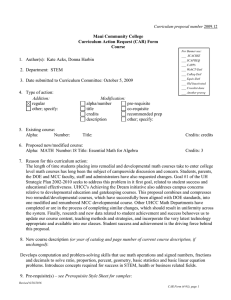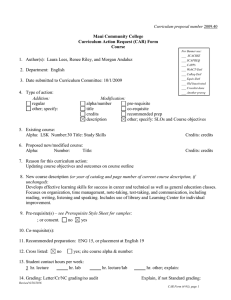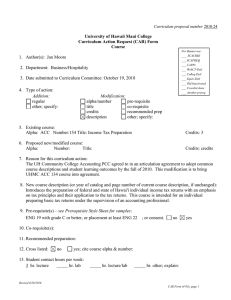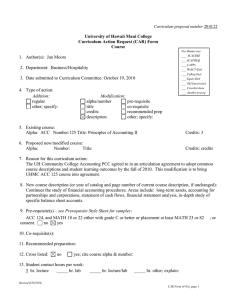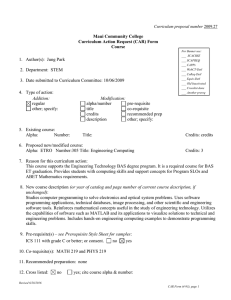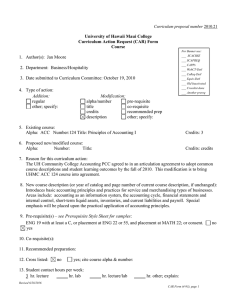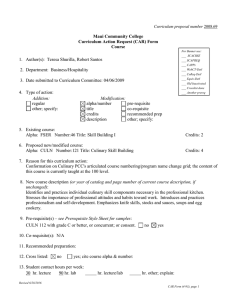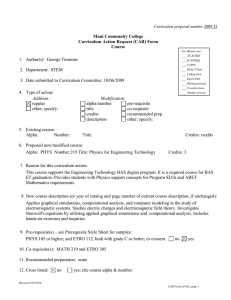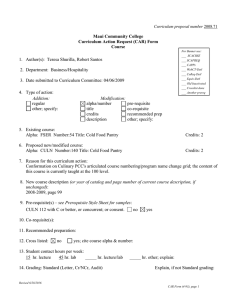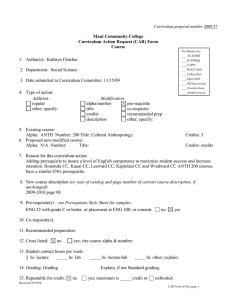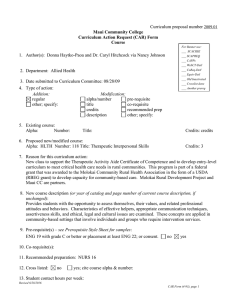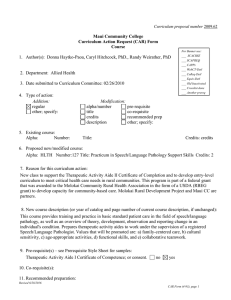Maui Community College Curriculum Action Request (CAR) Form Course
advertisement
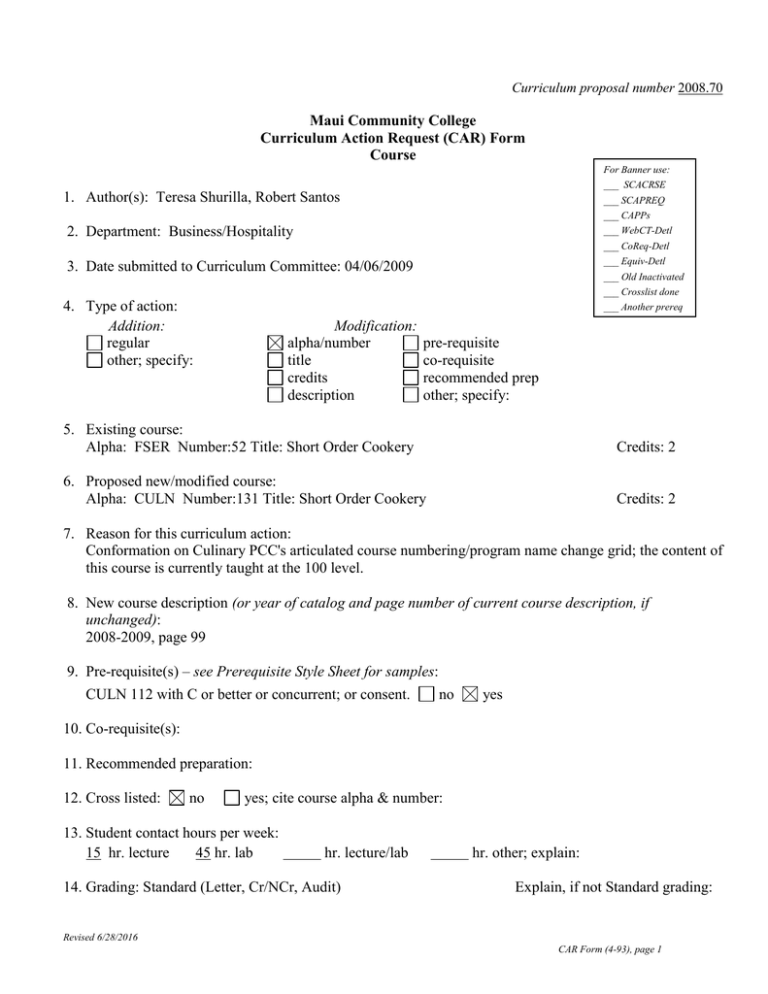
Curriculum proposal number 2008.70 Maui Community College Curriculum Action Request (CAR) Form Course For Banner use: ___ SCACRSE 1. Author(s): Teresa Shurilla, Robert Santos ___ SCAPREQ ___ CAPPs 2. Department: Business/Hospitality ___ WebCT-Detl ___ CoReq-Detl ___ Equiv-Detl 3. Date submitted to Curriculum Committee: 04/06/2009 ___ Old Inactivated ___ Crosslist done 4. Type of action: Addition: regular other; specify: ___ Another prereq Modification: alpha/number title credits description pre-requisite co-requisite recommended prep other; specify: 5. Existing course: Alpha: FSER Number:52 Title: Short Order Cookery Credits: 2 6. Proposed new/modified course: Alpha: CULN Number:131 Title: Short Order Cookery Credits: 2 7. Reason for this curriculum action: Conformation on Culinary PCC's articulated course numbering/program name change grid; the content of this course is currently taught at the 100 level. 8. New course description (or year of catalog and page number of current course description, if unchanged): 2008-2009, page 99 9. Pre-requisite(s) – see Prerequisite Style Sheet for samples: CULN 112 with C or better or concurrent; or consent. no yes 10. Co-requisite(s): 11. Recommended preparation: 12. Cross listed: no yes; cite course alpha & number: 13. Student contact hours per week: 15 hr. lecture 45 hr. lab hr. lecture/lab 14. Grading: Standard (Letter, Cr/NCr, Audit) hr. other; explain: Explain, if not Standard grading: Revised 6/28/2016 CAR Form (4-93), page 1 15. Repeatable for credit: no yes; maximum is credit or unlimited. (Most courses are not repeatable for additional credit; exceptions are courses such as internships and co-op courses.) 16. Special fees required: no yes; explain: 17. Proposed term of first offering: Spring semester of 2010 year. 18. List catalog used and then degrees, certificates, prerequisites, and catalog sections and their page numbers affected by this proposal: CO, CA, AAS; Certificates and Degrees pg. 41, 42; Course Descriptions, 99 19. Maximum enrollment: 15 Rationale, if less than 35: Safety, equipment and space issues and supervision 20. Special resources (personnel, supplies, etc.) required: no yes; explain: Food production supplies 21. Course is restricted to particular room type: no yes; explain: Kitchen production lab 22. Special scheduling considerations: no yes; explain: Campus meal hours 23. Method(s) of delivery appropriate for this course: (check all that apply) Traditional HITS/Interactive TV Cable TV Online Other, explain: Hybrid 24. Mark all college-wide general education SLOs this course supports. Std 1 - Written Communications Std 2 – Quantitative Reasoning Std 3 - Information Retrieval and Technology Std 4 - Oral Communication Std 5 - Critical Reasoning Std 6 – Creativity Other General Education SLOs, such as Ethics, Scientific Inquiry, or Service Learning. Explain: Ethics 25. List all program SLOs this course supports? (Explain, if necessary) Program SLO 1: X Program SLO 2: X Program SLO 3: X Program SLO 4: Program SLO 5: X 26. Explain: Use of tools and equipment Explain: Practice of safe food preparation and cookery Explain: Demonstrates leadership skills Explain: Explain: Demonstration of proper grooming, professional behavior and dress Course fulfills the following general education elective (GE) for CTE (Career Technical Education) AS/AAS degrees (GE): English (EN)/Communication (CM) Quantitative Reasoning (QR) Humanities (HU) Natural Science (NS) Social Science (SS) Other: Course is a requirement for the CULNprogram(s) AS/AAS degree or certificate Course is a program elective for the program(s) AS/AAS degree or certificate Revised 6/28/2016 CAR Form (4-93), page 2 27. Course fulfills the following general education elective (GE) for the ABIT BAS degree: English (EN)/Communication (CM) Quantitative Reasoning (QR) Humanities (HU) Natural Science (NS) Social Science (SS) Other: Course is a requirement for the ABIT BAS degree Course is a program elective for the ABIT BAS degree 28. Course fulfills a requirement for a proposed BAS degree: Pre- requisite course Core Capstone Course (CC) Other: Course is a program elective for a proposed BAS degree Course fulfills the following general education elective (GE) for the proposed BAS English (EN)/Communication (CM) Quantitative Reasoning (QR) Humanities (HU) Natural Science (NS) Social Science (SS) Other: Course is applicable to the following additional BAS degrees: 29. degree: Course satisfies the following category for the AA degree*: Category I: Foundations/Skills: Foundations I Written Communication in English (FW) Global and Multicultural Perspectives (FG) Group A (before 1500 CE) Group B (since 1500 CE) Group C (pre-history to present) Symbolic Reasoning (FS) Category I: Foundations/Skills: Foundations II Numeracy (FN) Oral Communication in English (FO) Computer/Information Processing and Retrieval (FI) Category II: Breadth of Understanding and Experience Human Understanding The Individual (IN) The Community (CO) The Community – Global Perspective (CG) Human Expression (HE) Environmental Awareness (EA) Environmental Awareness – Global Perspective (EG) Asia/Pacific Perspective (AP) Category III Focus/Specialization/Area of Interest Interest Area Discipline/Alpha: Elective (LE) Other Graduation Requirements Writing Intensive (is appropriate for WI) Environmental Awareness Lab/course with lab (EL) Hawaii Emphasis (HI) Revised 6/28/2016 CAR Form (4-93), page 3 * Submit the appropriate form(s) to have the course placed in the requested category (ies). Submit a course outline, CAR, and appropriate forms to both the Curriculum Committee and the Foundations Board, if the course satisfies Category I: Foundations/Skills: Foundations I or II. 30. Course increases decreases makes no change to number of credits required for program(s) affected by this action. Explain, if necessary: 31. Course is taught at another UH campus (see Sections 5 and 6 above): no Explain why this course is proposed for MCC: yes Specify college(s), course, alpha, and number where same or similar course is taught: HCC CULN 131, Short Order Cookery 32. Course is: Not appropriate for articulation. Appropriate* for articulation as a general education course at: UHCC UH Manoa UH Hilo UHWO Previously articulated* as a general education course at: UHCC UH Manoa UH Hilo UHWO *Note: Submit Course Articulation Form if course is already articulated, or is appropriate for articulation, as a general education (100-, 200-level) course. Standardized and/or appropriate for articulation by PCC or other UH system agreement at: UHCC UH Manoa UH Hilo UHWO Explain: Appropriate for articulation or has previously been articulated to a specific department or institution: UHCC UH Manoa UH Hilo UHWO Outside UH system Explain: 33. Additional Information (add additional pages if needed): Revised 6/28/2016 CAR Form (4-93), page 4 Maui Community College Curriculum Action Request (CAR) Signature Page __________________________________________________________________________ Proposed by: Author or Program Coordinator Date __________________________________________________________________________ Checked by: Academic Subject Area Representative to Curriculum Committee Date __________________________________________________________________________ Requested by Department: Department Chair Date __________________________________________________________________________ Recommended by: Curriculum Chair Date __________________________________________________________________________ Approved by Academic Senate: Academic Senate Chair Date __________________________________________________________________________ Endorsed by: Chief Academic Officer Date __________________________________________________________________________ Approved by: Chancellor Date Revised 6/28/2016 CAR Form (4-93), page 5 Maui Community College Course Outline 1. Alpha CULN Number 131 Course Title Short Order Cookery Credits 2 Department Business/Hospitality Date of Outline 03/24/2009 2. Course Description: Effective Date 04/06/2009 5-year Review Date Identifies and uses tools, equipment, supplies and foods used in a short order kitchen. Examines various positions in the short order kitchen. Practices, applies and analyzes principles of cookery and the service of short order foods Cross-list N/A Contact Hours/Type 15 Lecture, 45 Lab 3. Pre-requisites Author Teresa Shurilla, Robert Santos CULN 112 with C or better, or concurrent Pre-requisite may be waived by consent yes no Co-requisites Recommended Preparation 4. Function/Designation AS Program AA Category Category AAS Culinary Arts - Culinary Arts Programs and Category: BAS Program Category Developmental/Remedial Additional Category List Additional Programs and Category: PR - Program Requirement List Additional List Additional Programs and Category: Other/Additional: Explain: See Curriculum Action Request (CAR) form for the college-wide general education student learning outcomes (SLOs) and/or the program learning outcomes (PLOs) this course supports. This course outline is standardized and/or the result of a community college or system-wide agreement. Revised 6/28/2016 CAR Form (4-93), page 6 Responsible committee: PCC 5. Student Learning Outcomes (SLOs): List one to four inclusive SLOs. For assessment, link these to #7 Recommended Course Content, and #9 Recommended Course Requirements & Evaluation. Use roman numerals (I., II., III.) to designate SLOs On successful completion of this course, students will be able to: I. Identify and use equipment and supplies found in a short order kitchen II. Discuss and practice proper techniques in the service of short order foods III. Identify and prepare various foods in the short order kitchen IV. Discuss and follow proper safety and sanitation procedures 6. Competencies/Concepts/Issues/Skills For assessment, link these to #7 Recommended Course Content, and #9 Recommended Course Requirements & Evaluation. Use lower case letters (a., b.…zz. )to designate competencies/skills/issues On successful completion of this course, students will be able to: a. identify and use equipment, utensils and supplies commonly found in short order kitchens; b. discuss and follow standard sanitation and safety standards; c. operate, clean and maintain short order equipment properly, including the range, griddle, oven, deep fat fryer and microwave oven; d. discuss and practice the proper techniques involved in the service of short order and breakfast foods; e. describe and demonstrate the principles and procedures for deep fat frying; f. describe and use common dairy products and short order cookery techniques; and, g. identify and prepare meats, starches, various batters, eggs, and fruits commonly associated with the short order kitchen. 7. Suggested Course Content and Approximate Time Spent on Each Topic Linked to #5. Student Learning Outcomes and # 6 Competencies/Skills/Issues 1 week Introduction to MCC Cafeteria operations (a, b) a. Sanitation, safety and personal hygiene procedures (b), (IV) b. Identify and use short order kitchen tools and equipment (a, b, c), (I) 3 weeks Discussion of, preparation and service of meats, starches, various batters, eggs and fruits commonly associated with short order cookery. (d, e, f, g), (I, II, III, IV) a. Principles and procedures for deep fat frying (e), (I) 1 week Preparation and service of breakfast foods (d, f, g), (I, II, III, IV) 8. Text and Materials, Reference Materials, and Auxiliary Materials Revised 6/28/2016 CAR Form (4-93), page 7 Appropriate text(s) and materials will be chosen at the time the course is offered from those currently available in the field. Examples include: On Cooking, Sarah R. Labensky, Prentice Hall, Professional Cooking, Wayne Gisslen, John Wiley & Sons Appropriate reference materials will be chosen at the time the course is offered from those currently available in the field. Examples include: Appropriate auxiliary materials will be chosen at the time the course is offered from those currently available in the field. Examples include: 9. Suggested Course Requirements and Evaluation Linked to #5. Student Learning Outcomes (SLOs) and #6 Competencies/Skills/Issues Specific course requirements are at the discretion of the instructor at the time the course is being offered. Suggested requirements might include, but are not limited to: 10-50% Written quizzes, midterm(s) and/or a final exam covering lectures, discussions, media presentations, lab activities, field trips, guest speakers, and reading assignments (a-g), (I, II, III, IV) 5-30% Lab practical exams and product analysis and identification (a, c, d, e, f, g), (I, II, III, IV) 5-20% IV) Reading text assigned materials and answering discussion questions (d, e, f, g), (I, II, III, 5-20% IV) Participation in class discussions, group and individual/oral reports (c, d, e, f, g), (I, II, III, 20-50% Laboratory and/or field experiments and activities (a-g), (I, II, III, IV) 5-10% Field trip observations and assignments (a-g), (I, II, III, IV) 5-20% Projects, reports, and/or Service-Learning (a-g), (I, II, III, IV) 5-10% Punctuality, attendance and participation (a-g), (I, II, III, IV) 10. Methods of Instruction Instructional methods will vary considerably by instructor. Specific methods are at the discretion of the instructor teaching the course and might include, but are not limited to: a. b. c. d. e. f. g. lectures and discussions; quizzes and other tests with feedback and discussion; lab practical exams and product identification and analysis problem solving; videos, DVDs, CD-ROMs with discussion questions; lab activities including production of food for public sale; field trips including activities, observations and reports; Revised 6/28/2016 CAR Form (4-93), page 8 h. i. guest speakers; group activities; 11. Assessment of Intended Student Learning Outcomes Standards Grid attached 12. Additional Information: Assessment of Intended Student Learning Outcomes Standards Key: 3 = Major Emphasis: The student is actively involved (uses, reinforces, applies, and evaluated) in the student learning outcomes. The learner outcome is the focus of the class. 2 = Moderate Emphasis: The student uses, reinforces, applies and is evaluated by this learner outcome, but it is not the focus of the class 1 = Minor Emphasis: The student is provided an opportunity to use, reinforce, and apply this learner outcome but does not get evaluated on this learner outcome 0 = No Emphasis: The student does not address this learner outcome CULN Standard 1 - Written Communication Write effectively to convey ideas that meet the needs of specific audiences and purposes. 131 Outcome 1.1 - Use writing to discover and articulate ideas. Outcome 1.2 - Identify and analyze the audience and purpose for any intended communication. Outcome 1.3 - Choose language, style, and organization appropriate to particular purposes and audiences. Outcome 1.4 - Gather information and document sources appropriately. Outcome 1.5 - Express a main idea as a thesis, hypothesis, or other appropriate statement. Outcome 1.6 - Develop a main idea clearly and concisely with appropriate content. Outcome 1.7 - Demonstrate a mastery of the conventions of writing, including grammar, spelling, and mechanics. Outcome 1.8 - Demonstrate proficiency in revision and editing. Outcome 1.9 - Develop a personal voice in written communication. 2 2 2 2 2 2 2 1 2 Standard 2 - Quantitative Reasoning Synthesize and articulate information using appropriate mathematical methods to solve problems of quantative reasoning accurately and appropriately. Outcome 2.1 - Apply numeric, graphic, and symbolic skills and other forms of quantitative reasoning accurately and appropriately. Outcome 2.2 - Demonstrate mastery of mathematical concepts, skills, and applications, using technology when appropriate. Outcome 2.3 - Communicate clearly and concisely the methods and results of quantitative problem solving. Outcome 2.4 - Formulate and test hypotheses using numerical experimentation. Outcome 2.5 - Define quantitative issues and problems, gather relevant information, analyze that information, and present results. Outcome 2.6 - Assess the validity of statistical conclusions. 2 3 3 2 2 1 Standard 3 - Information Retrieval and Technology Access, evaluate, and utilize information effectively, ethically, and responsibly. Outcome 3.1 - Use print and electronic information technology ethically and responsibly. Outcome 3.2 - Demonstrate knowledge of basic vocabulary, concepts, and operations of information retrieval and technology. Outcome 3.3 - Recognize, identify, and define an information need. Outcome 3.4 - Access and retrieve information through print and electronic media, evaluating the accuracy and authenticity of that information. Outcome 3.5 - Create, manage, organize, and communicate information through electronic media. Outcome 3.6 - Recognize changing technologies and make informed choices about their appropriateness and use. Revised 6/28/2016 CAR Form (4-93), page 9 1 2 2 2 1 2 Standard 4 - Oral Communication Practice ethical and responsible oral communications appropriately to a variety of audiences and purposes. Outcome 4.1 - Identify and analyze the audience and purpose of any intended communication. Outcome 4.2 - Gather, evaluate, select, and organize information for the communication. Outcome 4.3 - Use language, techniques, and strategies appropriate to the audience and occasion. Outcome 4.4 - Speak clearly and confidently, using the voice, volume, tone, and articulation appropriate to the audience and occasion. Outcome 4.5 - Summarize, analyze, and evaluate oral communications and ask coherent questions as needed. Outcome 4.6 - Use competent oral expression to initiate and sustain discussions. 3 2 3 3 2 2 Standard 5 - Critical Thinking Apply critical thinking skills to effectively address the challenges and solve problems. Outcome 5.1 - Identify and state problems, issues, arguments, and questions contained in a body of information. Outcome 5.2 - Identify and analyze assumptions and underlying points of view relating to an issue or problem. Outcome 5.3 - Formulate research questions that require descriptive and explanatory analyses. Outcome 5.4 - Recognize and understand multiple modes of inquiry, including investigative methods based on observation and analysis. Outcome 5.5 - Evaluate a problem, distinguishing between relevant and irrelevant facts, opinions, assumptions, issues, values, and biases through the use of appropriate evidence. Outcome 5.6 - Apply problem-solving techniques and skills, including the rules of logic and logical sequence. Outcome 5.7 - Synthesize information from various sources, drawing appropriate conclusions. Outcome 5.8 - Communicate clearly and concisely the methods and results of logical reasoning. Outcome 5.9 - Reflect upon and evaluate their thought processes, value system, and world views in comparison to those of others. 3 3 2 2 2 2 3 2 2 Standard 6 - Creativity Able to express originality through a variety of forms 2 2 2 2 2 2 Outcome 6.1: Generate responses to problems and challenges through intuition and non-linear thinking Outcome 6.2: Explore diverse approaches to solving a problem or addressing a challenge Outcome 6.3: Sustain engagement in activities without a preconceived purpose Outcome 6.4: Apply creative principles to discover and express new idea Outcome 6.5: Demostrate the ability to trust and follow one's instincts in the absense of external direction Outcome 6.6: Build upon or adapt ideas of others to create novel expressions or new solutions Revised 6/28/2016 CAR Form (4-93), page 10
